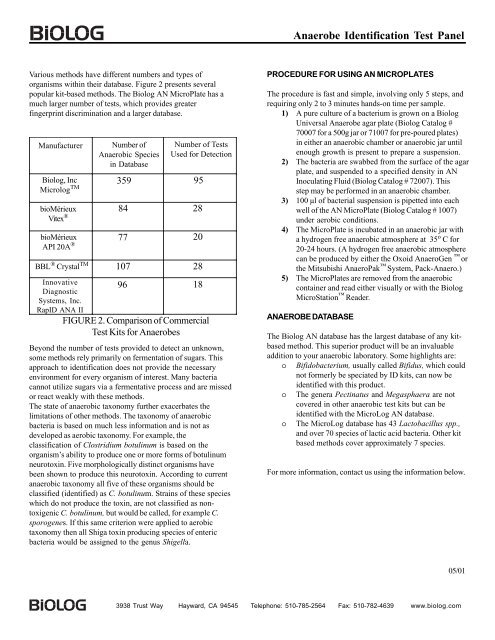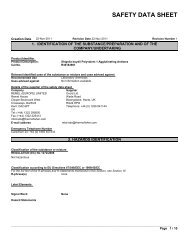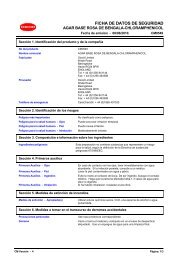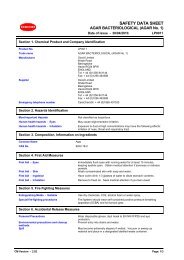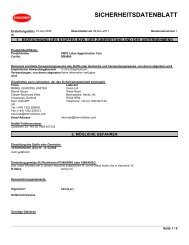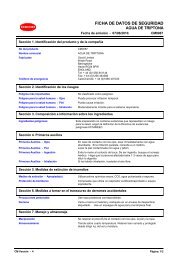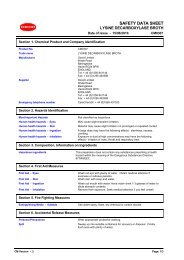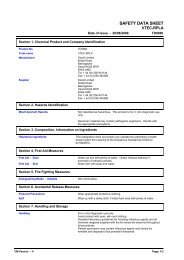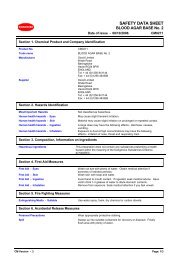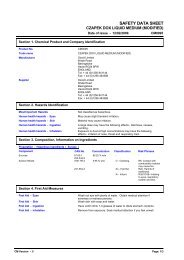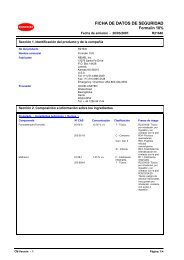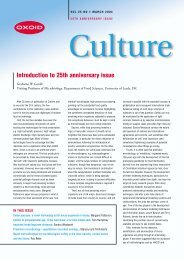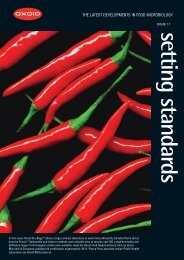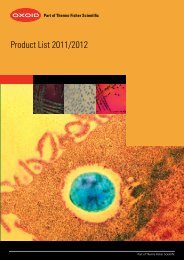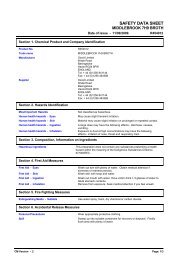AN MicroPlate - Oxoid
AN MicroPlate - Oxoid
AN MicroPlate - Oxoid
You also want an ePaper? Increase the reach of your titles
YUMPU automatically turns print PDFs into web optimized ePapers that Google loves.
Various methods have different numbers and types of<br />
organisms within their database. Figure 2 presents several<br />
popular kit-based methods. The Biolog <strong>AN</strong> <strong>MicroPlate</strong> has a<br />
much larger number of tests, which provides greater<br />
fingerprint discrimination and a larger database.<br />
Manufacturer Number of<br />
Anaerobic Species<br />
in Database<br />
Biolog, Inc<br />
Microlog TM<br />
bioMérieux<br />
Vitex ®<br />
bioMérieux<br />
API 20A ®<br />
BBL ® Crystal TM<br />
Innovative<br />
Diagnostic<br />
Systems, Inc.<br />
RapID <strong>AN</strong>A II<br />
Number of Tests<br />
Used for Detection<br />
359 95<br />
84 28<br />
77 20<br />
107 28<br />
96 18<br />
FIGURE 2. Comparison of Commercial<br />
Test Kits for Anaerobes<br />
Beyond the number of tests provided to detect an unknown,<br />
some methods rely primarily on fermentation of sugars. This<br />
approach to identification does not provide the necessary<br />
environment for every organism of interest. Many bacteria<br />
cannot utilize sugars via a fermentative process and are missed<br />
or react weakly with these methods.<br />
The state of anaerobic taxonomy further exacerbates the<br />
limitations of other methods. The taxonomy of anaerobic<br />
bacteria is based on much less information and is not as<br />
developed as aerobic taxonomy. For example, the<br />
classification of Clostridium botulinum is based on the<br />
organism’s ability to produce one or more forms of botulinum<br />
neurotoxin. Five morphologically distinct organisms have<br />
been shown to produce this neurotoxin. According to current<br />
anaerobic taxonomy all five of these organisms should be<br />
classified (identified) as C. botulinum. Strains of these species<br />
which do not produce the toxin, are not classified as nontoxigenic<br />
C. botulinum, but would be called, for example C.<br />
sporogenes. If this same criterion were applied to aerobic<br />
taxonomy then all Shiga toxin producing species of enteric<br />
bacteria would be assigned to the genus Shigella.<br />
Anaerobe Identification Test Panel<br />
PROCEDURE FOR USING <strong>AN</strong> MICROPLATES<br />
The procedure is fast and simple, involving only 5 steps, and<br />
requiring only 2 to 3 minutes hands-on time per sample.<br />
1) A pure culture of a bacterium is grown on a Biolog<br />
Universal Anaerobe agar plate (Biolog Catalog #<br />
70007 for a 500g jar or 71007 for pre-poured plates)<br />
in either an anaerobic chamber or anaerobic jar until<br />
enough growth is present to prepare a suspension.<br />
2) The bacteria are swabbed from the surface of the agar<br />
plate, and suspended to a specified density in <strong>AN</strong><br />
Inoculating Fluid (Biolog Catalog # 72007). This<br />
step may be performed in an anaerobic chamber.<br />
3) 100 µl of bacterial suspension is pipetted into each<br />
well of the <strong>AN</strong> <strong>MicroPlate</strong> (Biolog Catalog # 1007)<br />
under aerobic conditions.<br />
4) The <strong>MicroPlate</strong> is incubated in an anaerobic jar with<br />
a hydrogen free anaerobic atmosphere at 35 o C for<br />
20-24 hours. (A hydrogen free anaerobic atmosphere<br />
can be produced by either the <strong>Oxoid</strong> AnaeroGen or<br />
the Mitsubishi AnaeroPak System, Pack-Anaero.)<br />
5) The <strong>MicroPlate</strong>s are removed from the anaerobic<br />
container and read either visually or with the Biolog<br />
MicroStation Reader.<br />
<strong>AN</strong>AEROBE DATABASE<br />
The Biolog <strong>AN</strong> database has the largest database of any kitbased<br />
method. This superior product will be an invaluable<br />
addition to your anaerobic laboratory. Some highlights are:<br />
o Bifidobacterium, usually called Bifidus, which could<br />
not formerly be speciated by ID kits, can now be<br />
identified with this product.<br />
o The genera Pectinatus and Megasphaera are not<br />
covered in other anaerobic test kits but can be<br />
identified with the MicroLog <strong>AN</strong> database.<br />
o The MicroLog database has 43 Lactobacillus spp.,<br />
and over 70 species of lactic acid bacteria. Other kit<br />
based methods cover approximately 7 species.<br />
For more information, contact us using the information below.<br />
3938 Trust Way Hayward, CA 94545 Telephone: 510-785-2564 Fax: 510-782-4639 www.biolog.com<br />
05/01
<strong>AN</strong> <strong>MicroPlate</strong> <br />
Anaerobe Identification Test Panel<br />
A1 A2 A3 A4 A5 A6 A7 A8 A9 A10 A11 A12<br />
N-Acetyl- N-Acetyl- N-Acetyl- Adonitol Amygdalin D-Arabitol Arbutin D-Cellobiose α-Cyclodextrin β-Cyclodextrin Dextrin<br />
Water D-Galactosamine D-Glucosamine D-Mannosamine<br />
B1 B2 B3 B4 B5 B6 B7 B8 B9 B10 B11 B12<br />
Dulcitol I-Erythritol D-Fructose L-Fucose D-Galactose D-Galacturonic Gentiobiose D-Gluconic D-Glucosaminic α-D-Glucose Glucose-1- Glucose-6-<br />
Acid Acid Acid Phosphate Phosphate<br />
C1 C2 C3 C4 C5 C6 C7 C8 C9 C10 C11 C12<br />
Glycerol D,L-α-Glycerol m-Inositol α-D-Lactose Lactulose Maltose Maltotriose D-Mannitol D-Mannose D-Melezitose D-Melibiose 3-Methyl-<br />
Phosphate D-Glucose<br />
D1 D2 D3 D4 D5 D6 D7 D8 D9 D10 D11 D12<br />
α-Methyl- β-Methyl- α-Methyl- β-Methyl- Palatinose D-Raffinose L-Rhamnose Salicin D-Sorbitol Stachyose Sucrose D-Trehalose<br />
D-Galactoside D-Galactoside D-Glucoside D-Glucoside<br />
E1 E2 E3 E4 E5 E6 E7 E8 E9 E10 E11 E12<br />
Turanose Acetic Acid Formic acid Fumaric Acid Glyoxylic Acid α- Hydroxy- β- Hydroxy- Itaconic Acid α-Ketobutyric α-Ketovaleric D,L-Lactic L-Lactic Acid<br />
butyric Acid butyric Acid Acid Acid Acid<br />
F1 F2 F3 F4 F5 F6 F7 F8 F9 F10 F11 F12<br />
D-Lactic Acid D-Malic Acid L-Malic Acid Propionic Acid Pyruvic Acid Pyruvic Acid D-Saccharic Succinamic Succinic Acid Succinic Acid M-Tartaric Acid Urocanic Acid<br />
Methyl Ester Methyl Ester Acid Acid Mono-Methyl<br />
Ester<br />
G1 G2 G3 G4 G5 G6 G7 G8 G9 G10 G11 G12<br />
Alaninamide L-Alanine L-Alanyl- L-Alanyl- L-Alanyl- L-Asparagine L-Glutamic Acid L-Glutamine Glycyl- Glycyl- Glycyl- Glycyl-<br />
L-Glutamine L-Histidine L-Threonine L-Aspartic Acid L-Glutamine L-Methionine L-Proline<br />
H1 H2 H3 H4 H5 H6 H7 H8 H9 H10 H11 H12<br />
L-Methionine L-Phenylalanine L-Serine L-Threonine L-Valine L-Valine plus 2'-Deoxy Inosine Thymidine Uridine Thymidine-5'- Uridine-5'-<br />
L-Aspartic Acid Adenosine Mono-phosphate Mono-phosphate<br />
INTRODUCTION<br />
The Biolog <strong>AN</strong> <strong>MicroPlate</strong> (Figure 1) is designed for<br />
identification of a very wide range of anaerobic bacteria,<br />
including the genera Bifidobacterium, Clostridium,<br />
Eubacterium, Fusobacterium, Lactobacillus, Lactococcus,<br />
Megasphaera, Pectinatus, Pediococcus, Peptostreptococcus,<br />
Propionibacterium and Weissella. These genera are important<br />
in industrial and environmental applications, especially the<br />
food industry where they are responsible for both food<br />
production and food spoilage. Some clinical species are not<br />
currently in our database. These will be added when they<br />
meet our performance criteria. The <strong>AN</strong> <strong>MicroPlate</strong> employs<br />
the same redox chemistry used in the Biolog GP2 and GN2<br />
<strong>MicroPlate</strong>s. This chemistry, based on reduction of<br />
tetrazolium, responds to the process of metabolism (oxidation<br />
of substrates) rather than to metabolic by-products (e.g. acid).<br />
Biolog’s universal chemistry works with any carbon source<br />
and greatly simplifies the testing process, as no color<br />
developing chemicals need to be added after incubation.<br />
<strong>AN</strong> MICROPLATE<br />
The Anaerobe Database contains over 350 taxa of anaerobic<br />
bacteria including over 70 species of lactic acid bacteria.<br />
FIGURE 1. Carbon Source in <strong>AN</strong> <strong>MicroPlate</strong><br />
The Biolog <strong>AN</strong> <strong>MicroPlate</strong> performs 95 discrete tests<br />
simultaneously and gives a characteristic reaction pattern<br />
called a “metabolic fingerprint”. These fingerprint reaction<br />
patterns provide a vast amount of information conveniently<br />
contained on a single Biolog <strong>MicroPlate</strong>. The patterns are<br />
compared using Biolog MicroLog database software to give<br />
an identification.<br />
Other anaerobic kit-based identification methods rely on fewer<br />
tests to perform identifications. Therefore an anaerobic<br />
organism that was previously characterized by another method<br />
may yield an identification result that differs from the Biolog<br />
<strong>AN</strong> <strong>MicroPlate</strong> & Database. This difference may be due to<br />
several factors. When determining the validity of an<br />
anaerobic identification result from the Biolog <strong>AN</strong> <strong>MicroPlate</strong><br />
and another method, consider the following:<br />
o The MicroLog System bases its identification on a<br />
larger number of tests<br />
o The MicroLog System covers more species<br />
o The taxonomy of many anaerobic genera is poorly<br />
defined


